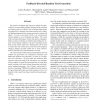1145 search results - page 88 / 229 » The Correctness of an Optimized Code Generation |
CODES
2005
IEEE
14 years 2 months ago
2005
IEEE
Byte-code based languages are slowly becoming adopted in embedded domains because of improved security and portability. Another potential reason for their adoption is the reputati...
DMS
2010
13 years 7 months ago
2010
In-lined Reference Monitoring frameworks are an emerging technology for enforcing security policies over untrusted, mobile, binary code. However, formulating correct policy specifi...
ICSE
2007
IEEE-ACM
14 years 9 months ago
2007
IEEE-ACM
We present a technique that improves random test generation by incorporating feedback obtained from executing test inputs as they are created. Our technique builds inputs incremen...
CASES
2005
ACM
13 years 11 months ago
2005
ACM
Code compression is a field where compression ratios between compiler-generated code and subsequent compressed code are highly dependent on decisions made at compile time. Most op...
ACSAC
2008
IEEE
14 years 3 months ago
2008
IEEE
In its most general form, an attack signature is a program that can correctly determine if an input network packet sequence can successfully attack a protected network application...

